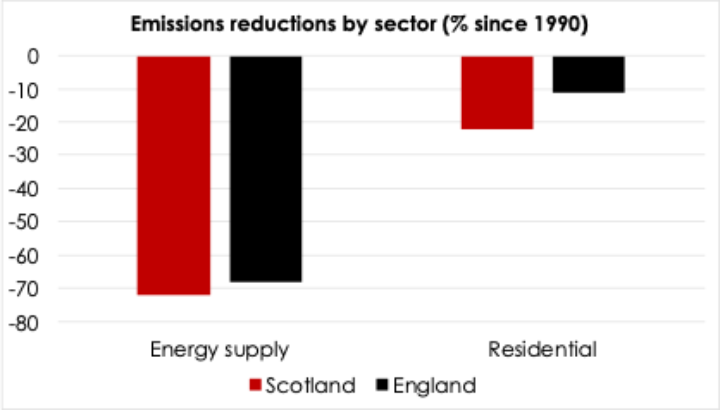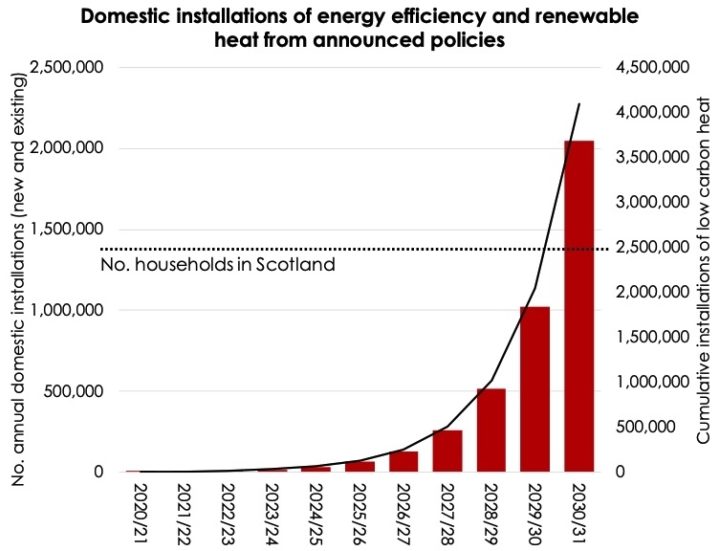Clean heat – the UK government could do worse than look north of the border
Scotland's investment in decarbonising homes and buildings dwarfs England's. Is there still opportunity for the Heat and Buildings Strategy to turn it around?

By Jess Ralston
@jessralston2Share
Last updated:
For understandable reasons, 2020 is yet to live up to its moniker as the ‘year of climate action’. However, big decisions that will dictate the UK’s path to net zero emissions remain both urgent and imminent, especially on how we keep warm at home.
The Government’s Heat and Buildings Decarbonisation Strategy is vitally important for cutting emissions and is due this autumn. Somewhat handily for decision-makers in Whitehall, the Scottish Government’s latest Programme for Government contains a good outline of what ambition looks like.
Residential sector is one of the main barriers
The urgency to tackle emissions from heat arises from a lack of progress compared with other sectors.
In Scotland, whilst energy supply emissions have fallen by 72% since 1990, residential progress is less than half of that at just -22%. England’s record is even worse, with a 68% fall in energy supply comparing to a measly -11% in residential.

Thus, success in this area is reliant on strong, ambitious action from the UK Central Government.
Despite this, Scotland has an accelerated net zero timeline compared to the rest of the Great Britain. And to reflect this, its 2020/21 Programme for Government goes beyond what the Central UK Government has so far promised.
Scots storm ahead
The Scottish Government’s programme for 2020/21, released in early September, pledges a total of nearly £1.6 billion to transform buildings, ensuring ‘that emissions from heating are eliminated by 2040’ and ‘poor energy efficiency as a driver of fuel poverty’ is removed.
This may seem small against the £9.2 billion promised in the Conservative manifesto for improving the energy efficiency of English homes, schools and hospitals, especially once considering the English funding is spread over a four-year time period compared to Scotland’s six.
However, it’s important to note that so far only £2 billon of the energy efficiency spend has currently been realised, via the Green Homes Grant. Add in expectations under the Low Carbon Heat Support Scheme, and current total ambition sits at 625,000 homes – just 2% of Britain’s housing stock.
(Note: this does not include Energy Company Obligation (ECO) data, a policy set up to support energy efficiency and low carbon heating in Great Britain – this is because since ECO3 began in October 2018, it has supported over 100,000 fossil fuel gas boilers, more than the number of loft and cavity wall insulations combined.)
Conversely, the Scottish Government highlighted that their ambitions at the very least are to double the rate of renewable heat installations in new and existing homes and buildings every year. They can also benefit from the schemes introduced across the whole of Great Britain – doubling up on investment and leaving England and Wales behind.

Their ambitions in renewable heating will take the current baseline of just 2,000 installations per year in 2020 to 64,000 homes fitted in 2025 – a cumulative total of around 126,000 homes. That’s 5% of Scotland’s housing stock in one policy alone – over double what no. 10 has promised in its programme set out for heat and energy efficiency so far.
This ambition for renewable heating, if continued, would see all of Scotland’s homes decarbonised by 2030/31.
| England | Scotland | |
|---|---|---|
Households | 27,800,000 | 2,500,000 |
Number of households covered by policy to date | 625,000 | 126,000 |
Spend to date | £2.1 billion | £555 million |
Announced investment per household | £3,360 | £4,405 |
Percent of total households covered | 2.2% | 5% |
Investment
Figures for how pledged spending will be divvied up further emphasises Scotland’s ambitious approach.
Scotland’s investment per household is larger by half compared to England’s; £4,405 per home in Scotland compared to £3,360 south of the border.

Through this investment, Scotland expects to create at least 5,000 jobs by 2025. In comparison, the UK Government’s Clean Heat Grant expects to ‘support 100,000’ jobs, but gives no detail on jobs creation.
At a time when green jobs offer a clean recovery and a wealth of skilled employment after coronavirus, it’s striking that the UK Government hasn’t set out how many new jobs they think new policies can create.
Holding back
Energy Minister Kwasi Kwarteng recently highlighted, ‘in practice the devolution arrangement is complicated’ as some policy levers that can be pulled, such as fuel standards and specifications, are fully reserved to Westminster.
This means that much of what Scotland can do with heat, such as widespread changes to the blends of gas that’s pumped into the grid, is restricted.
This has not gone unnoticed. On Scotland’s 2045 net zero target, the CCC has said ‘these [net zero] targets are contingent on the UK adopting our recommended 2050 net-zero GHG target. Scotland cannot deliver net-zero emissions by 2045 through devolved policy alone. It will require both UK-wide and Scottish policies to ramp up significantly.’
While Scotland is clearly leading the rest of the UK on housing decarbonisation, pitfalls remain in the path ahead. Yet more delays to the Heat and Buildings Strategy – originally pledged for mid-2020 – only up the ante on the need to get it right.
Share